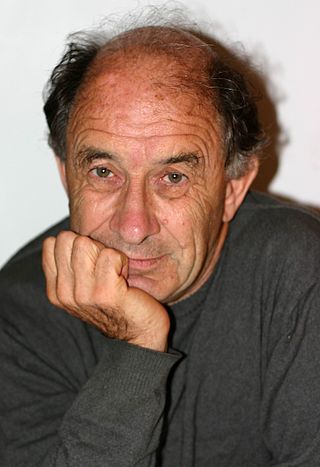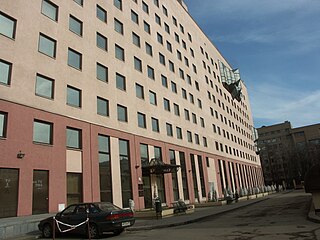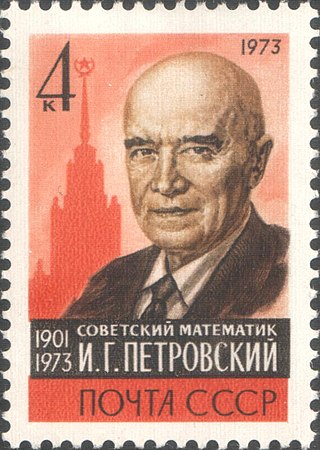
Grigory Isaakovich Barenblatt was a Russian mathematician.

Vladimir Igorevich Arnold was a Soviet and Russian mathematician. He is best known for the Kolmogorov–Arnold–Moser theorem regarding the stability of integrable systems, and contributed to several areas, including geometrical theory of dynamical systems, algebra, catastrophe theory, topology, real algebraic geometry, symplectic geometry, differential equations, classical mechanics, differential-geometric approach to hydrodynamics, geometric analysis and singularity theory, including posing the ADE classification problem.

Andrey Nikolaevich Kolmogorov was a Soviet mathematician who played a central role in the creation of modern probability theory. He also contributed to the mathematics of topology, intuitionistic logic, turbulence, classical mechanics, algorithmic information theory and computational complexity.

Israel Moiseevich Gelfand, also written Israïl Moyseyovich Gel'fand, or Izrail M. Gelfand was a prominent Soviet-American mathematician. He made significant contributions to many branches of mathematics, including group theory, representation theory and functional analysis. The recipient of many awards, including the Order of Lenin and the first Wolf Prize, he was a Foreign Fellow of the Royal Society and professor at Moscow State University and, after immigrating to the United States shortly before his 76th birthday, at Rutgers University. Gelfand is also a 1994 MacArthur Fellow.

Nikolai Nikolayevich Luzin was a Soviet and Russian mathematician known for his work in descriptive set theory and aspects of mathematical analysis with strong connections to point-set topology. He was the eponym of Luzitania, a loose group of young Moscow mathematicians of the first half of the 1920s. They adopted his set-theoretic orientation, and went on to apply it in other areas of mathematics.
The Keldysh Institute of Applied Mathematics is a research institute specializing in computational mathematics. It was established to solve computational tasks related to government programs of nuclear and fusion energy, space research and missile technology. The Institute is a part of the Department of Mathematical Sciences of the Russian Academy of Sciences. The main direction of activity of the institute is the use of computer technology to solve complex scientific and technical issues of practical importance. Since 2016, the development of mathematical and computational methods for biological research, as well as a direct solution to the problems of computational biology with the use of such methods, has also been included in the circle of scientific activities of the institute.

Steklov Institute of Mathematics or Steklov Mathematical Institute is a premier research institute based in Moscow, specialized in mathematics, and a part of the Russian Academy of Sciences. The institute is named after Vladimir Andreevich Steklov, who in 1919 founded the Institute of Physics and Mathematics in Leningrad. In 1934, this institute was split into separate parts for physics and mathematics, and the mathematical part became the Steklov Institute. At the same time, it was moved to Moscow. The first director of the Steklov Institute was Ivan Matveyevich Vinogradov. From 1961–1964, the institute's director was the notable mathematician Sergei Chernikov.
Sergei Vasilyevich Fomin was a Soviet mathematician who was co-author with Andrey Kolmogorov of Introductory real analysis, and co-author with Israel Gelfand of Calculus of Variations (1963), both books that are widely read in Russian and in English.

David Kazhdan, born Dmitry Aleksandrovich Kazhdan, is a Soviet and Israeli mathematician known for work in representation theory. Kazhdan is a 1990 MacArthur Fellow.
Alexander Osipovich Gelfond was a Soviet mathematician. Gelfond's theorem, also known as the Gelfond-Schneider theorem is named after him.

Ivan Georgiyevich Petrovsky was a Soviet mathematician working mainly in the field of partial differential equations. He greatly contributed to the solution of Hilbert's 19th and 16th problems, and discovered what are now called Petrovsky lacunas. He also worked on the theories of boundary value problems, probability, and on the topology of algebraic curves and surfaces.

Andrei Vladlenovich Zelevinsky was a Russian-American mathematician who made important contributions to algebra, combinatorics, and representation theory, among other areas.
Vladimir Solomonovich Retakh is a Russian-American mathematician who made important contributions to Noncommutative algebra and combinatorics among other areas.
Zorya Yakovlevna Shapiro was a Soviet mathematician, educator and translator. She is known for her contributions to representation theory and functional analysis in her collaboration with Israel Gelfand, and the Shapiro-Lobatinski condition in elliptical boundary value problems.
Vladimir Igorevich Bogachev is an eminent Russian mathematician and Full Professor of the Department of Mechanics and Mathematics of the Lomonosov Moscow State University. He is an expert in measure theory, probability theory, infinite-dimensional analysis and partial differential equations arising in mathematical physics. His research was distinguished by several awards including the medal and the prize of the Academy of Sciences of the Soviet Union (1990); Award of the Japan Society for the Promotion of Science (2000); the Doob Lecture of the Bernoulli Society (2017); and the Kolmogorov Prize of the Russian Academy of Sciences (2018).
Dmitrii Abramovich Raikov was a Russian mathematician who studied functional analysis.
Nikolai Nikolaevich Chentsov, written also as Nikolaj Nikolajevič Čencov, or Nikolai Chentsov, N. N. Čencov for short, was a Soviet mathematician who made important contributions to stochastic processes, convergence theory and information geometry.









